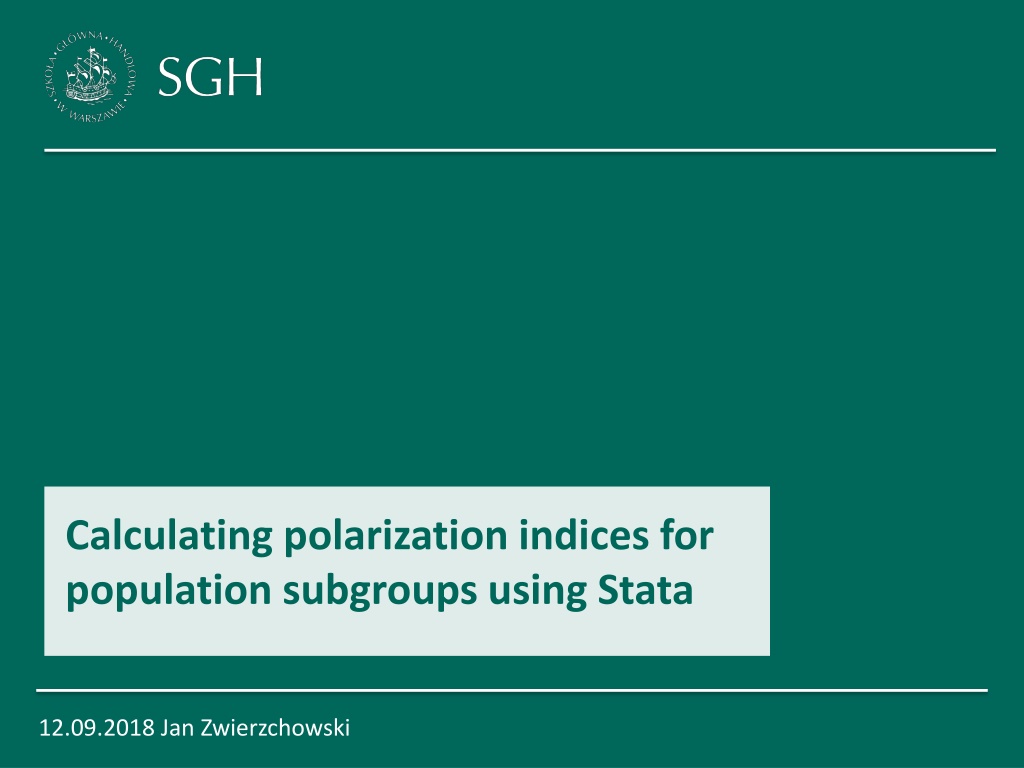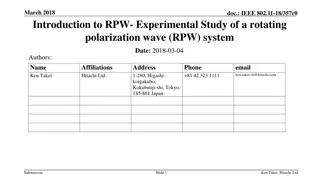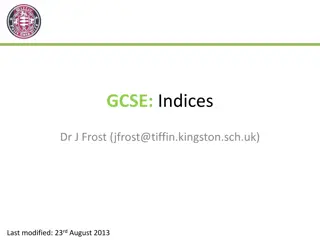Understanding Economic Polarization and Polarization Indices
Explanation of the concept of economic polarization and the calculation of polarization indices for population subgroups using Stata. Discusses the disappearance of the middle income class, misuse of the term economic polarization, and measures like the median relative polarization index (MRP) for assessing income distributions over time. Provides formulas for MRP calculation for both whole populations and subgroups.
Download Presentation

Please find below an Image/Link to download the presentation.
The content on the website is provided AS IS for your information and personal use only. It may not be sold, licensed, or shared on other websites without obtaining consent from the author. Download presentation by click this link. If you encounter any issues during the download, it is possible that the publisher has removed the file from their server.
E N D
Presentation Transcript
Calculating polarization indices for population subgroups using Stata 12.09.2018 Jan Zwierzchowski 1
Polarisation Concept of economic polarization has been used since the 1980s to describe the disappearance of the middle income class in the USA; middle class is a commonly used term, but vague; The notion of economic polarization is frequently used incorrectly to describe the increase of income inequality; Economic polarisation describes a process in which income focuses on two separate poles or groups (one rich, and the other poor), which causes the disappearance of the middle income class. 12.09.2018 Calculating polarization indices for population subgroups using Stata 2
Measures of Polarisation The median relative polarization index (MRP) was proposed by Morris, Bernhardt and Handcock (1994); The MRP is based on a comparison of income distributions in two periods: 1 1 r ( ) r = 4 1 MRP g dr = = 1 1 t t 2 0 Where: ( ) ( ) y f y ( ) r = = 1 t , 0 1 g r = 1 t f = 0 t 12.09.2018 Calculating polarization indices for population subgroups using Stata 3
MRP for real data For individual data (discrete distribution), the MPR index takes the following form: n n 4 1 4 1 = = ( ) y 1 1 t t = i = i = = 1 1 MRP R F = = 1 0 t i t i 2 n n 2 1 1 = = 1 1 t t The above index measures the average absolute deviation from the median of the effect function, normalized to vary between -1 and 1. 12.09.2018 Calculating polarization indices for population subgroups using Stata 4
Generalisation: the MRP index for subgroups The MRP index is normalised between -1 and 1 if and only if it is implemented for the whole population; There is no reason not to generalise the formula, so that it is capable of assessing of polarisation in population subgroups; The simplest formula for an index for a subgroup would be: log 2 1 1 1 ( ) r 1 = G G G 1 MRP r g dr G 2 D = = 1 1 t t G G t 2 D n = 1 0 where G denotes a certain subgroup of the whole population 12.09.2018 Calculating polarization indices for population subgroups using Stata 5
Generalisation: the MRP index for subgroups The proposed formula in case of real data takes form: log 2 G t n 1 1 1 = 1 i = G 1 MRP R G 2 D = 1 t i G G 2 D n 1 = 1 t Where the normalisation coefficient is equall to: ( ) i G n 1 = G t = n 1 1 F y = 1 t i 2 = D 1 G t 12.09.2018 Calculating polarization indices for population subgroups using Stata 6
Case of panel data The generalised formula does not inform on the polarisation within a subgroup of individuals, it rather informs on the polarisation in a certain region of the distribution; What if we have panel data and observe change in the belongingness of units to certain subgroups over time? Should this additional implemented to the analysis? We believe that it should be implemented, as this kind of information allows for the full assessment of the polarisation within subgroups. information be somehow 12.09.2018 Calculating polarization indices for population subgroups using Stata 7
Further generalisation: MRP index for panel data The proposed formula for panel data incorporates a history element: log 2 G t G t n n 1 1 2 1 1 1 = = ( ) y ( ) y 1 1 i i = + G 1 MRP R F F G 2 D = = = 1 t i i 1 0 i t t G G G 2 2 2 D n n 1 1 = 1 t The first element accounts for the change in the distribution shape over time, while the second element measures the individual changes in relative incomes of units belonging to the analysed subgroup. 12.09.2018 Calculating polarization indices for population subgroups using Stata 8
Data source The empirical analysis was based on the polish Social Diagnosis Panel Database; The Database contains a panel of household which covers the 2005-2015 period (over 700 households); The income category used is the net monthly equivalent income of households The middle class was defined by two absolute income limits the lower equal to social minimum, the upper equal to second income tax threshold. 12.09.2018 Calculating polarization indices for population subgroups using Stata 9
Calculating generalised MRP indices with Stata A do file was created co calculate indices; The do file was written in a way that it can be quickly transformed into ado file; Standard errors were calculated using bootstraping; The inference on the significance of estimates is certainly not valid, as their distribution is asymmetrical; As of today this is still work in progress. 12.09.2018 Calculating polarization indices for population subgroups using Stata 10
Empirical results Poland 2005-2015 Fractions in the distinguished groups: Year Class limits (in Household fractions PLN) wLC wMC wHC y' y" 2005 1,030 5,610 0.508 0.486 0.006 2015 1,030 5,610 0.176 0.802 0.021 The fraction of household groups wMC w MC wEP wNEP wMC wLC,HC Subgroup Fraction 0.302 0.135 0.167 0.698 0.606 0.093 12.09.2018 Calculating polarization indices for population subgroups using Stata 11
Empirical results Poland 2005-2015 Index MRP Standard z p- 95% confidence type MRP MRP1 MRP1 MRP1 MRP1 MRP1 MRP MRP1 MRP= MRP indices -0.0006 -0.0083 -0.0768 0.1814 -0.0287 0.2569* -0.0685* 0.051 0.0222 -0.0184 0.0931 error 0.036 0.037 0.121 0.341 0.048 0.139 statistic -0.017 0.220 -0.634 0.532 -0.604 1.850 -1.348 0.586 -0.422 0.808 value 0.986 [-0.069; 0,072] 0.826 [-0.067; 0,085] 0.526 [-0.335; 0,198] 0.595 [-0.492; 0,256] 0.546 [-0.120; 0,064] 0.032 [-0.007; 0,541] 0.089 [-0.166; 0,033] 0.558 [-0.049; 0.099] 0.673 [-0.099; 0.072] 0.419 [-0.147; 0.300] interval = t 1 MC = LC t = HC = EP t = MC t t t = MC =1 NEP = MC t = t 0.038 0.044 0.115 t ' 1 , LC HC 1 t 12.09.2018 Calculating polarization indices for population subgroups using Stata 12
Empirical results Poland 2005-2015 A fraction of households belonging to the middle class (defined by absolute limits) increased from 48,6% in 2005 to 80,2% in 2015 as a result of growth in real incomes; The polarisation index was virtually equall to 0 there was no polarisation of incomes; The analysis of indices for groups reveal a more intricate picture there was a strong polarisation in the upper class the rich grew even richer, while the poor and the middle class converged toward median income. 12.09.2018 Calculating polarization indices for population subgroups using Stata 13
Conclusions A new set of polarisation indices has been proposed; It allows for a more thorough analysis of economic polarisation, in particular, for the analysis in certain distinguished subgroups of the population; A Stata command is being written, which allows for calculating the new indices using survey panel data; It is not clear how inference on their significance should be conducted. 12.09.2018 Calculating polarization indices for population subgroups using Stata 14
References Duclos J-Y., Esteban J., Ray D.,(2004). Polarization: Concepts, Measurement, Estimation. Econometrica, Vol. 72, No. 6, pp. 1737 1772; Handcock M. S., Morris M., (1999). Relative Distribution Methods in the Social Sciences, New York: Springer; Horrigan H., Haugen S., (1988). The Declining Middle Class: a Sensitivity Analysis, Monthly Labour Rev., No. 111, pp. 3-13 Panek T., Zwierzchowski J. Median Relative Partial Income Polarization Indices: Investigating Economic Polarization in Poland during the year 2005-2015. 12.09.2018 Calculating polarization indices for population subgroups using Stata 15

























